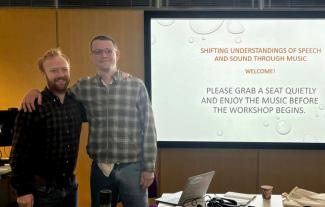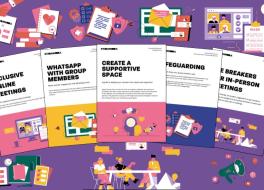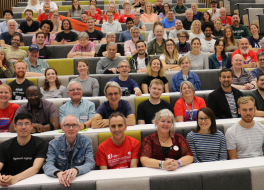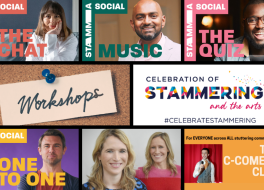Seeing stammering as music

Doctor and keen audiophile Joshua Walker tells us all about the workshop he co-hosted at our conference last year all about using stammering as a musical device.
French composer Edgard Varese famously defined music simply as 'organised sound'. I wonder if he would have seen stammering as music. It has all the basic elements: loudness, pitch, rhythm, tempo and reverb. Stammering as music, what do you think? Ridiculous idea or rebellious flavour?
Miles Davis, the famous jazz trumpeter, described his improvisational technique in parallel to the way Picasso used a canvas. He said the most critical aspects of his work were not the objects themselves — the notes. Instead it was the space between them, the 'air' that he placed between notes that was most important. This got me thinking about blocks when you stammer. What happens if we think of blocks as 'air'? How might that transform our understanding of them? Can they be both absence and potential, a capacity for expression revealed?
What happens if we think of blocks as 'air'? How might that transform our understanding of them?
Can we keep going and think of repetitions as 'emphasis' and prolongations as 'shifts in tempo'? If we did, we might agree with fellow jazz musicians Herbie Hancock and Thelonious Monk that "there are no wrong notes, just better choices".
No wrong notes
Stammering as music. That was the gauntlet I laid down to 30 people during the workshop 'Shifting understanding of speech and sound through music' at the STAMMAFest conference in Nottingham last year. They'd walked in to the song 'Cmon' by Fred Again/Brian Eno (the power of attention! Despite hundreds of years of collective expertise, no-one noticed the stammered sounds in the music). Their job was to use stammering as a 'musical device', reading extracts of poems by Paul Dunbar, Emily Dickinson and Jordan Scott. The goal was to develop the meaning of the poems with a stammer, using repetitions, prolongations and pauses. No wrong notes, just better choices.
After delivering the poems, groups got to work. In ten minutes, they discussed how different concepts in the poems might be communicated better. People connected with adjectives and emotions and making further connections to stammering and sound. It was an abstract task bringing an array of interpretations. Eight brave souls then stepped up and recited their renditions into a microphone, 'surrendering to the art' before we all performed a chant en masse to finish.
The effect that I had hoped for came about: people breathed life into their voices, finding a wide range of depth and expression.
It. Was. B-b-b-b-beautiful. Each approach was different, every voice unique. It was so refreshing to speak and listen in an environment where stammering was a prized possession, a useful tool. One person decided to face the audience, to try and make him stammer more. The sounds of birds and waves were enhanced by creative uses of soft and plosive sounds. The effect that I had hoped for came about: people breathed life into their voices, finding a wide range of depth and expression. It was an honour to capture it all and mix the voices together over music into a 'poetry soup'. Listen to the recording we made.
Offering a fresh perspective
Besides being a lot of fun, I hope the experience might offer a portal into real life. Seeing stammering as musical play might not be a complete approach to communication. Life at times demands more than jazz improvisation (if only!). But by entering the experience of stammering as musical play, I think we can find fresh perspective. To see how our intention and perception of value transforms experience. To find agency and a playful creative freedom in everyday life.
Following Oscar Wilde's observation that life imitates art, by emulating Fred Again when ordering a drink in Starbucks might seem ambitious. But it certainly adds a rebellious flavour to a hum-drum activity that most of us wish away.
Stepping down the 'speaking hierarchy', approaching everyday activities with the same spirit, every b-b-b-bounce into a b-bus ticket, aaaaannouncing an arrival at a restaurant with a-PLOMB, we might find communication and play get closer together.
Follow this Spotify playlist for an assortment of jazz and electronic tracks to feel inspired and get music into stammering today!
About the author
Josh is a person who stammers and a medical doctor living in London. He has an interest in internal medicine, ageing and palliative care. As an audiophile, Josh enjoys a wide range of musical genres from classical to Jazz to electronic. He has been through City Lit intensive and public speaking speech therapy courses and has enjoyed approaching stammering from a 'social' lens. This has included giving presentations and writing a chapter in the book 'Stammering Pride and Prejudice' on Narrative approaches to stammering.
Read more Your Voice articles.
Would you like to write something? Share your journey with stammering, or maybe your opinion on something. Or tell us about a stammering-related project you're involved with. See Submit Something For The Site or email editor@stamma.org for details.

































